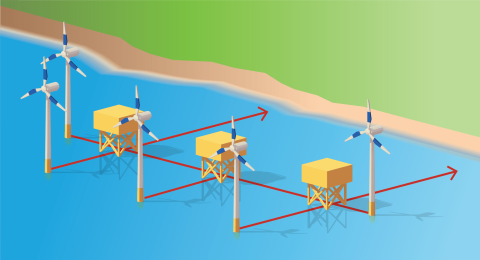The U.S. Department of Energy (DOE), in partnership with the U.S. Department of the Interior’s (DOI) Bureau of Ocean Energy Management (BOEM), was developing strategic offshore transmission to allow resources to be captured off the coasts of the United States and delivered to communities as reliable power.
National Activities and Technical Assistance
Atlantic Coast
- Atlantic Offshore Wind Transmission Convening Series
- Action Plan for Offshore Wind Transmission Development in the U.S. Atlantic Region
- Northeast States Collaborative on Interregional Transmission
- Standardization for Interregional Offshore Wind Transmission
- Atlantic Offshore Wind Transmission Study
West Coast
- Action Plan for Offshore Wind Transmission Development in the U.S. West Coast Region
- West Coast Offshore Wind Transmission Convening Series
- West Coast Offshore Wind Transmission Literature Review and Gaps Analysis
- West Coast Offshore Wind Transmission Study
Gulf Coast
- Gulf of Mexico Offshore Wind Transmission Literature Review and Gaps Analysis
- Gulf of Mexico Coastal and Offshore Transmission Study
- In January 2025, DOE’s Grid Deployment Office funded the Pacific Northwest National Laboratory (PNNL) and the National Renewable Energy Laboratory (NREL) to begin the Gulf of Mexico Coastal and Offshore Transmission Study. To help inform state and local policymakers and the public in the Gulf region, this study will identify pathways that enable both onshore and offshore transmission access and promote resilient grid operation for long term energy development in the Gulf of Mexico focusing on integrated interregional approaches and considering reliability, cost, and community impacts.
Resources
Wind Energy
The "grid", or transmission system, is a complex network of power lines and machinery working around the clock to move electricity from where it is generated to millions of homes and businesses across the nation where it is used. An offshore wind turbine or wind farm (a set of wind turbines) can generate electricity, but that electricity has to travel a long way to make it to shore. However, we do not currently have a transmission grid out in the ocean. If we want to enhance harnessing offshore wind energy, then we need to build new offshore transmission infrastructure.
Offshore transmission infrastructure is more than just one long cable running along the ocean floor. While we can connect offshore wind with a single (also known as a radial) line, there are a lot of benefits to connecting it to multiple points onshore through a network. An offshore network means we can connect multiple offshore wind projects and deliver power to multiple coastal communities with one connected system.
Network Topology
Multiple paths of power from the system to the onshore grid increases its reliability.
Offshore wind plants are represented as single turbines.
Benefits
Select each card to learn more.
Contact Us
For additional questions, contact the team at OSWtransmission@hq.doe.gov. Learn more about GDO’s funding and financing programs: Grid and Transmission Program Conductor.


